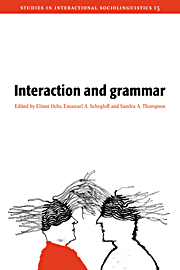Book contents
- Frontmatter
- Contents
- Notes on the contributors
- 1 Introduction
- 2 Turn organization: one intersection of grammar and interaction
- 3 Interactional units in conversation: syntactic, intonational, and pragmatic resources for the management of turns
- 4 Resources and repair: a cross-linguistic study of syntax and repair
- 5 On the “semi-permeable” character of grammatical units in conversation: conditional entry into the turn space of another speaker
- 6 On repeats and responses in Finnish conversations
- 7 “When I come down I'm in the domain state”: grammar and graphic representation in the interpretive activity of physicists
- 8 Transparent vision
- 9 Conversational signifying: grammar and indirectness among African American women
- 10 Creating evidence: making sense of written words in Bosavi
- Appendix Transcription conventions
- Index
4 - Resources and repair: a cross-linguistic study of syntax and repair
Published online by Cambridge University Press: 14 January 2010
- Frontmatter
- Contents
- Notes on the contributors
- 1 Introduction
- 2 Turn organization: one intersection of grammar and interaction
- 3 Interactional units in conversation: syntactic, intonational, and pragmatic resources for the management of turns
- 4 Resources and repair: a cross-linguistic study of syntax and repair
- 5 On the “semi-permeable” character of grammatical units in conversation: conditional entry into the turn space of another speaker
- 6 On repeats and responses in Finnish conversations
- 7 “When I come down I'm in the domain state”: grammar and graphic representation in the interpretive activity of physicists
- 8 Transparent vision
- 9 Conversational signifying: grammar and indirectness among African American women
- 10 Creating evidence: making sense of written words in Bosavi
- Appendix Transcription conventions
- Index
Summary
Introduction
The organization of repair in conversation has been the focus of much work in conversation analysis and related fields over the last twenty years (e.g., Hockett, 1967; Du Bois, 1974; Jefferson, 1974, 1987; Moerman, 1977; Schegloff, Sacks, and Jefferson, 1977; Schegloff, 1979, 1987a; Goodwin, 1981; Levelt, 1982, 1983, 1989; Carbonell and Hayes, 1983; Hindle, 1983; Levelt and Cutler, 1983; Reilly, 1987; van Wijk and Kempen, 1987; Good, 1990; Postma, Kolk, and Povel, 1990; Bredart, 1991; Blacker and Mitton, 1991; Bear, Dowding, and Shriberg, 1992; Couper-Kuhlen, 1992; Local, 1992; Shriberg, Bear, and Dowding, 1992; Nakatani and Hirschberg, 1993). This work has uncovered the mechanisms of self- and other-initiation of repair, self- and other-achievement of repair, repair position, perception of repair, and so on. But within this fairly extensive literature, the relationships between repair and syntax have received relatively little attention (the major exceptions being Schegloff, 1979; Goodwin, 1981; Levelt, 1983; Geluykens, 1987; van Wijk and Kempen, 1987; Fox and Jasperson, frth.). And the operation of repair in different languages, with different syntactic systems, has, to the best of our knowledge, been the object of only a small body of research (see Schegloff, 1987b).
This present study aims to begin to fill this gap by focusing on the syntax of repair from a cross-linguistic perspective. Cross-linguistic work on repair is especially compelling to us given our own, and others”, research on the relationships between same-turn (also known as first-position) self-repair and syntax in English conversation (Schegloff, 1979, this volume; Fox and Jasperson, frth.).
- Type
- Chapter
- Information
- Interaction and Grammar , pp. 185 - 237Publisher: Cambridge University PressPrint publication year: 1996
- 94
- Cited by



